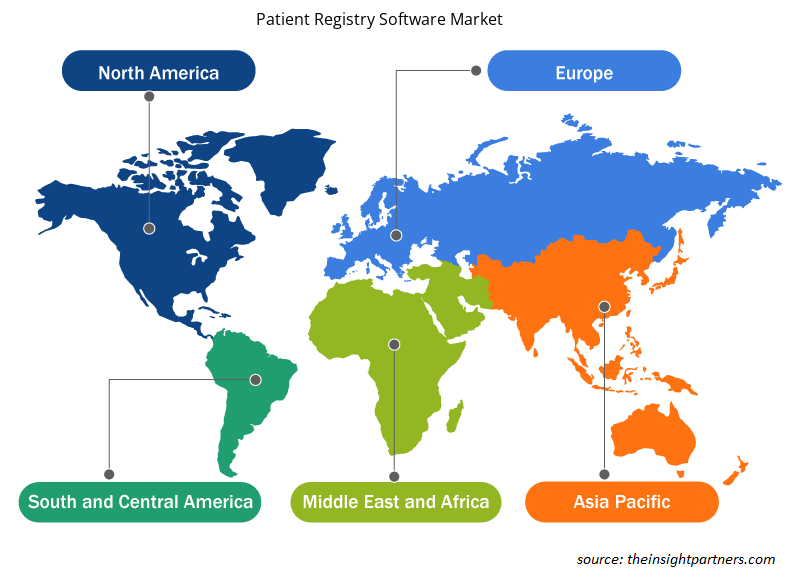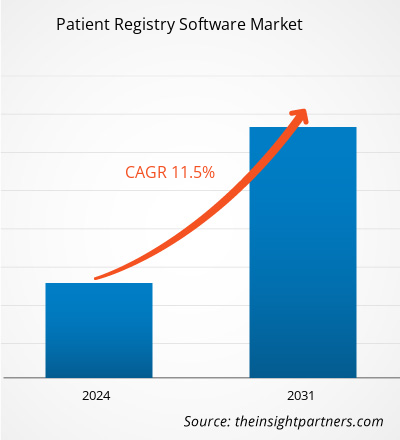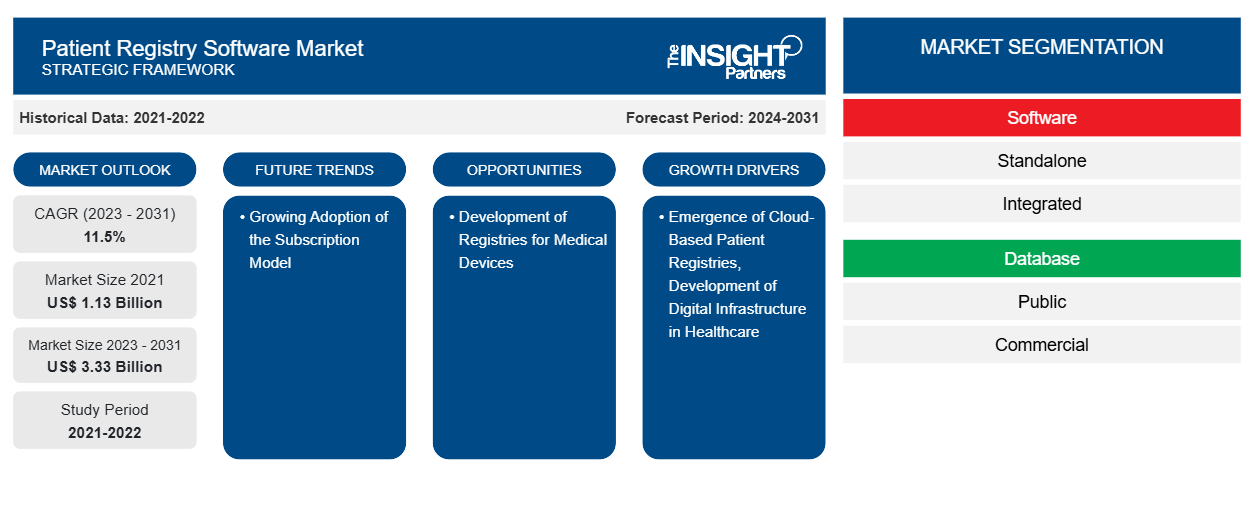El tamaño del mercado de software de registro de pacientes en 2021 fue de 1.130 millones de dólares y se proyecta que alcance los 3.330 millones de dólares en 2031. Se espera que el mercado registre una CAGR del 11,5 % entre 2023 y 2031. Es probable que el desarrollo de registros para dispositivos médicos siga siendo una tendencia clave en el mercado de software de registro de pacientes.
Análisis del mercado de software de registro de pacientes
Se prevé que la creciente prevalencia de enfermedades crónicas a nivel mundial impulse el crecimiento del mercado. La necesidad de registros médicos electrónicos (EHR) ha aumentado sustancialmente debido a la creciente prevalencia de diabetes, enfermedades cardiovasculares, cáncer y otras enfermedades. La industria de la atención médica está experimentando una transformación notable como resultado de la creciente presión para reducir costos, la implementación de iniciativas gubernamentales favorables y la creciente accesibilidad a las redes sociales y las tecnologías móviles. Se prevé que todos estos factores beneficien al mercado de software de registro de pacientes durante el período de pronóstico.
Descripción general del mercado de software de registro de pacientes
El software de registro de pacientes contiene bases de datos que se mantienen mediante la recopilación de datos secundarios relacionados con el diagnóstico, el procedimiento o la condición de un paciente, para registrar el número de nuevos dispositivos médicos que se utilizan o que pasan por un nuevo procedimiento. El software de registro de pacientes es crucial en la vigilancia posterior a la comercialización de los productos farmacéuticos. En diciembre de 2020, la Unión Europea otorgó 66 millones de dólares a varios proyectos de salud digital con el objetivo de luchar contra las crisis sanitarias, como la pandemia de COVID-19, y establecer una infraestructura digital y de inteligencia artificial en Europa. La asistencia financiera alienta a las empresas de salud digital a desarrollar e introducir productos avanzados en el mercado del software de registro de pacientes. Por lo tanto, la creciente incorporación de herramientas digitales en la estructura de atención médica impulsa el crecimiento del mercado.
Personalice este informe según sus necesidades
Obtendrá personalización en cualquier informe, sin cargo, incluidas partes de este informe o análisis a nivel de país, paquete de datos de Excel, así como también grandes ofertas y descuentos para empresas emergentes y universidades.
-
Obtenga las principales tendencias clave del mercado de este informe.Esta muestra GRATUITA incluirá análisis de datos, desde tendencias del mercado hasta estimaciones y pronósticos.
Factores impulsores y oportunidades del mercado del software de registro de pacientes
La aparición de registros de pacientes basados en la nube impulsa el crecimiento del mercado
Los médicos independientes han utilizado registros médicos electrónicos basados en la nube o en la web desde hace algunos años. Varias organizaciones están creando y desarrollando registros basados en la nube para numerosas afecciones y procedimientos médicos. Por ejemplo, el Orphan Disease Center colaboró con Pulse Infoframe, una empresa de informática médica, para crear un conjunto de registros de pacientes con enfermedades raras en tecnologías basadas en la nube. Allscripts junto con Northwell Health firmaron un acuerdo innovador para generar el EHR de próxima generación en octubre de 2019. La iniciativa respalda la generación masiva de ingresos. Además, los servicios de software basados en la nube son eficientes para su uso en términos de costo, ya que solo se deben pagar por los servicios y registros requeridos. Por lo tanto, la aparición de registros de pacientes basados en la nube está impulsando la expansión del mercado.
La creciente adopción del modelo de suscripción favorece el crecimiento del mercado
El modelo de suscripción minimiza los costos iniciales y alivia la presión sobre los sistemas de atención médica, ya que no se necesita personal de TI. Como resultado de esto, la rentabilidad y la productividad aumentan. Para llegar a los clientes potenciales y consumidores de formas novedosas, este modelo también permite a los proveedores crear modelos de licencia innovadores y creativos. El software con modelos de suscripción se está volviendo cada vez más popular entre los proveedores de atención médica, ya que permite un tiempo más rápido para obtener valor por cualquier característica nueva agregada al programa, así como también puede usarse por un tiempo limitado, según las necesidades. El modelo de suscripción también está siendo promovido por varios actores de la industria, ya que brinda una mayor oportunidad de desarrollar confianza y comprender las necesidades de los proveedores de atención médica, mejorando en última instancia la satisfacción del cliente. Estos beneficios ofrecen oportunidades a los actores del mercado para la expansión, impulsando así el crecimiento del mercado durante el período de pronóstico.
Informe de segmentación del mercado de software de registro de pacientes
Los segmentos clave que contribuyeron a la derivación del análisis del mercado de software de registro de pacientes son el software, la base de datos, el tipo de registro, el modo de entrega y el modelo de precios.
- Según el software, el mercado de software de registro de pacientes se divide en independiente e integrado. El segmento integrado tuvo la mayor participación de mercado en 2023 y se prevé que registre la CAGR más alta durante el período de pronóstico.
- Según la base de datos, el mercado está segmentado en público y comercial. El segmento comercial tuvo la mayor participación del mercado en 2023 y se proyecta que registre la CAGR más alta durante el período de pronóstico.
- En términos de tipo de registro, el mercado se clasifica en registro de productos, registro de enfermedades y registro de servicios de salud. El segmento de registro de enfermedades tuvo la mayor participación de mercado en 2023 y se prevé que registre la CAGR más alta durante el período de pronóstico.
- Según el modo de entrega, el mercado de software de registro de pacientes se divide en local y basado en la nube. El segmento basado en la nube tuvo la mayor participación de mercado en 2023 y se prevé que registre la CAGR más alta durante el período de pronóstico.
- Según el modelo de precios, el mercado se segmenta en suscripción y propiedad. El segmento de suscripción tuvo la mayor participación del mercado en 2023 y se proyecta que registre la CAGR más alta durante el período de pronóstico.
Análisis de la cuota de mercado del software de registro de pacientes por geografía
El alcance geográfico del informe de mercado del software de registro de pacientes se divide principalmente en cinco regiones: América del Norte, Asia Pacífico, Europa, Medio Oriente y África, y América del Sur y Central.
América del Norte ha dominado el mercado de software de registro de pacientes. El mercado de América del Norte se está expandiendo debido a varios factores, incluidos los registros médicos electrónicos bien establecidos, la infraestructura digital en evolución en el cuidado de la salud y la creciente conciencia de los pacientes sobre los beneficios de los registros de pacientes. Es probable que el mercado de software de registro de pacientes en la región aumente con la presencia de varios actores clave en el mercado que adquieren proveedores regionales y recopiladores de registros para fortalecer sus posiciones existentes. Además, la obligación de las autoridades federales de integrar el uso de herramientas digitales en las operaciones de atención médica para expandir la calidad y reducir los costos al mismo tiempo también es responsable de aumentar el crecimiento del mercado en la región. Se anticipa que Asia Pacífico crecerá con la CAGR más alta en los próximos años. Es probable que el mercado sea testigo de un crecimiento considerable en la región debido al surgimiento de centros médicos en la región, el crecimiento de la industria de TI de atención médica, el creciente énfasis en la salud digital, la atención en la racionalización de procesos y las políticas gubernamentales de apoyo.
Perspectivas regionales del mercado de software de registro de pacientes
Los analistas de Insight Partners explicaron en detalle las tendencias y los factores regionales que influyen en el mercado de software de registro de pacientes durante el período de pronóstico. Esta sección también analiza los segmentos y la geografía del mercado de software de registro de pacientes en América del Norte, Europa, Asia Pacífico, Oriente Medio y África, y América del Sur y Central.

- Obtenga datos regionales específicos para el mercado de software de registro de pacientes
Alcance del informe de mercado del software de registro de pacientes
| Atributo del informe | Detalles |
|---|---|
| Tamaño del mercado en 2021 | 1.130 millones de dólares estadounidenses |
| Tamaño del mercado en 2031 | US$ 3.33 mil millones |
| CAGR global (2023 - 2031) | 11,5% |
| Datos históricos | 2021-2022 |
| Período de pronóstico | 2024-2031 |
| Segmentos cubiertos |
Por software
|
| Regiones y países cubiertos |
América del norte
|
| Líderes del mercado y perfiles de empresas clave |
|
Densidad de actores del mercado de software de registro de pacientes: comprensión de su impacto en la dinámica empresarial
El mercado de software de registro de pacientes está creciendo rápidamente, impulsado por la creciente demanda de los usuarios finales debido a factores como la evolución de las preferencias de los consumidores, los avances tecnológicos y una mayor conciencia de los beneficios del producto. A medida que aumenta la demanda, las empresas amplían sus ofertas, innovan para satisfacer las necesidades de los consumidores y aprovechan las tendencias emergentes, lo que impulsa aún más el crecimiento del mercado.
La densidad de actores del mercado se refiere a la distribución de las empresas o firmas que operan dentro de un mercado o industria en particular. Indica cuántos competidores (actores del mercado) están presentes en un espacio de mercado determinado en relación con su tamaño o valor total de mercado.
Las principales empresas que operan en el mercado de software de registro de pacientes son:
- Compañía: IQVIA Inc.
- Evado Clínico
- Cedaron
- Corporación IBM
- FIGmd Inc.
- Transmisión médica
Descargo de responsabilidad : Las empresas enumeradas anteriormente no están clasificadas en ningún orden particular.

- Obtenga una descripción general de los principales actores clave del mercado de software de registro de pacientes
Noticias y desarrollos recientes del mercado de software de registro de pacientes
El mercado de software de registro de pacientes se evalúa mediante la recopilación de datos cualitativos y cuantitativos posteriores a la investigación primaria y secundaria, que incluye publicaciones corporativas importantes, datos de asociaciones y bases de datos. A continuación, se incluye una lista de los avances en el mercado de software de registro de pacientes y las estrategias:
- Seqster PDM, Inc., la empresa líder en tecnología sanitaria centrada en el paciente, ha firmado una alianza de varios años con la National Pancreas Foundation para crear el registro de pacientes con enfermedades pancreáticas más grande e inclusivo del país. El nuevo e innovador registro impulsado por Seqster se conecta a cualquier historia clínica electrónica, prueba de ADN genómico y dispositivo de monitorización portátil o remoto, lo que proporciona a los pacientes un historial médico longitudinal completo en tiempo real. (Fuente: Seqster PDM, Inc., comunicado de prensa, 2022)
- La Academia Estadounidense de Pediatría seleccionó a ArborMetrix como su socio para desarrollar y hacer crecer un registro clínico para mejorar la salud, el bienestar y el desarrollo de todos los niños. El programa, el Registro de Mejora de la Salud Infantil a través de Datos Longitudinales (CHILD), apoya a los 67.000 pediatras miembros de la AAP en la mejora de la salud infantil mediante el uso de datos del mundo real. Recopila, almacena y analiza de forma segura datos de salud de niños en todo Estados Unidos. (Fuente: ArborMetrix, comunicado de prensa, 2020)
Informe de mercado sobre software de registro de pacientes: cobertura y resultados
El informe “Tamaño y pronóstico del mercado del software de registro de pacientes (2021-2031)” proporciona un análisis detallado del mercado que cubre las siguientes áreas:
- Tamaño del mercado y pronóstico a nivel global, regional y nacional para todos los segmentos clave del mercado cubiertos bajo el alcance
- Dinámica del mercado, como impulsores, restricciones y oportunidades clave
- Principales tendencias futuras
- Análisis detallado de las cinco fuerzas de Porter y PEST y FODA
- Análisis del mercado global y regional que cubre las tendencias clave del mercado, los principales actores, las regulaciones y los desarrollos recientes del mercado.
- Análisis del panorama de la industria y de la competencia que abarca la concentración del mercado, el análisis de mapas de calor, los actores destacados y los desarrollos recientes
- Perfiles detallados de empresas
- Análisis histórico (2 años), año base, pronóstico (7 años) con CAGR
- Análisis PEST y FODA
- Tamaño del mercado, valor/volumen: global, regional y nacional
- Industria y panorama competitivo
- Conjunto de datos de Excel
Informes recientes
Informes relacionados
Testimonios
Razón para comprar
- Toma de decisiones informada
- Comprensión de la dinámica del mercado
- Análisis competitivo
- Información sobre clientes
- Pronósticos del mercado
- Mitigación de riesgos
- Planificación estratégica
- Justificación de la inversión
- Identificación de mercados emergentes
- Mejora de las estrategias de marketing
- Impulso de la eficiencia operativa
- Alineación con las tendencias regulatorias























 Obtenga una muestra gratuita para - Mercado de software de registro de pacientes
Obtenga una muestra gratuita para - Mercado de software de registro de pacientes